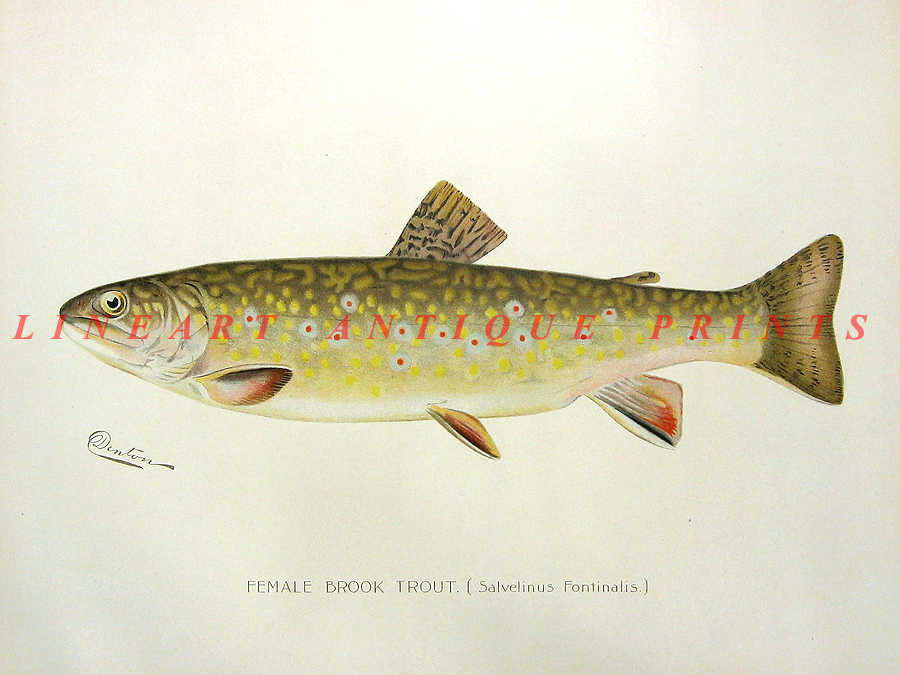%0d%0aFEMALE BROOK TROUT. (Salvelinus Fontinalis) %0d%0aArtist: Sherman Denton |

NOTE: THE RED LETTERING ON THE PRINT IS A WATERMARK I ADDED DIGITALLY AND IS NOT ON THE ACTUAL PRINT!
We pack properly to protect your item!
The brook trout, Salvelinus fontinalis, (sometimes called the eastern brook trout) is a species of fish in the salmon family of order Salmoniformes. In many parts of its range, it is known as the speckled trout or squaretail. A potamodromous population in Lake Superior are known as coaster trout or, simply, as coasters. Though commonly called a trout, the brook trout is actually a char, along with lake trout, bull trout, Dolly Varden and the Arctic char. The brook trout is native to small streams, creeks, lakes, and spring ponds. Some brook trout are anadromous. It is native to a wide area of eastern North America but increasingly confined to higher elevations southward in the Appalachian Mountains to northern Georgia, Canada from the Hudson Bay basin east, the Great Lakes–Saint Lawrence system, and the upper Mississippi River drainage as far west as eastern Iowa. Brook trout from lake in Wyoming's Wind River Range.Colouration: green to brown basic colouration with a distinctive marbled pattern (called vermiculations) of lighter shades across the flanks and back and extending at least to the dorsal fin, and often to the tail. There is a distinctive sprinkling of red dots, surrounded by blue haloes, along the flank. The belly and lower fins are reddish in color, the latter with white leading edges. Often the belly, particularly of the males, becomes very red or orange when the fish are spawning. The species reaches a maximum recorded length of 86 cm (33 in) and a maximum recorded weight of 6.6 kg (14.5 lb). It can reach at least seven years of age, with reports of 15-year-old specimens observed in California habitats to which the species has been introduced. The brook trout is a popular game fish with anglers, particularly fly fishermen. Today, many anglers practice catch-and-release tactics to preserve remaining brook trout populations, and organizations such as Trout Unlimited have been in the forefront of efforts to institute air and water quality standards sufficient to protect the brook trout. Revenues derived from the sale of fishing licenses have been used to restore many sections of creeks and streams to brook trout habitat. Brook trout are also commercially raised in large numbers for food production, being sold for human consumption in both fresh and smoked forms. Because of its dependence on pure water and a variety of aquatic and insect life forms, the brook trout is also used for scientific experimentation in assessing the effects of pollution. Partially as a result of its popularity as a game fish, the brook trout has been introduced in some areas to which it was not originally native, and has become established widely throughout the world. In some parts of the world, the brook trout has had a harmful effect on native species, and is a potential pest.
Sherman Foote Denton (1856-1937) was born in Wellesley, Massachusetts , S.F. Denton was a multi-talented artist, scientist and skilled entrepreneur in business. His interest in natural history encompassed not only fish, but butterflies and moths, insects, birds, fossils, freshwater pearls and gems. During the 1880s, he and his brothers went on trips to the Western U.S. and accompanied their father, a geologist, on an expedition to Australia, New Zealand and New Guinea, where collected natural history specimens. Returning to the U.S., Denton worked as an artist for the United States Fish Commission at the Smithsonian Institute between 1896 and 1890, where he illustrated their reports with chromolithograph prints and also developed and patented a method for mounting fish without losing the natural colors. He became the leading maker of fish models for collectors and museums such as the Smithsonian, the Field Museum in Chicago and the Agassiz Museum at Harvard. He also invented a method for mounting butterflies, and amassed the most important collection of freshwater pearls in the U.S. Sherman, along with his brothers William, Winsford and Shelley (a noted naturalist in his time) became famous at the 1900 Paris Exposition for their award-winning moth and butterfly collections. Sherman Denton was also renowned among the leading naturalists of his day for developing and patenting methods to preserve fish, butterflies and moths in a much more life-like state.